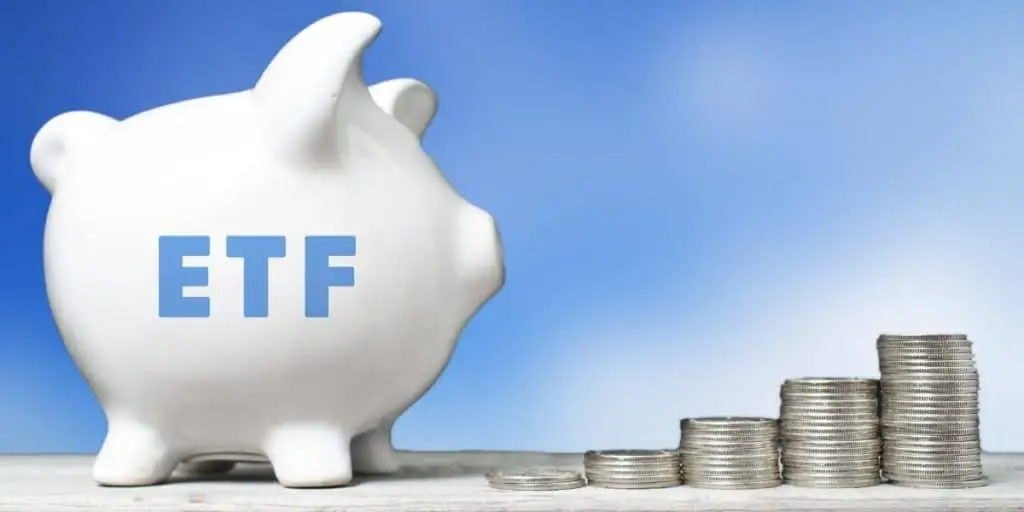You’ve heard of ETFs – securities sold on an exchange – and want to diversify your portfolio and make more profit using them. ETFs are easy to trade and understand. But do they have a market cap?
ETFs have a market cap and it fluctuates with the price of the different securities that an ETF holds. In fact, the market cap of ETFs frequently fluctuates during trading. The demand for ETFs is growing, and with that, the overall market cap of ETFs is also growing. Investors are increasingly looking at ETFs as a cost effective way to diversify their investments today.
This article will provide the necessary information about what ETFs are, how they work, how they are built, and why they are great to diversify an investment portfolio.
Now, without further ado, let us get started.
IMPORTANT SIDENOTE: I surveyed 1500+ traders to understand how social trading impacted their trading outcomes. The results shocked my belief system! Read my latest article: ‘Exploring Social Trading: Community, Profit, and Collaboration’ for my in-depth findings through the data collected from this survey!
Table of Contents
What Is an ETF?
ETFs are investment funds that help investors pool money to invest in stocks, bonds, and other assets. The investors, in return, receive every piece of assets in the fund. You can buy one ETF share, then have a stake in the whole investment owned by the ETF.

Because of the platform used to buy and sell ETFs — an exchange — they’re often referred to as exchange-traded funds. It’s designed to track anything from the cost of the individual commodity to an extensive collection of securities. An ETF’s price fluctuates throughout the trading day.
One of the most popular ETFs is the SPDR S&P 500 ETF Trust (SPY), a basket of stocks from the S&P 500 Index.
ETFs are popular because their management fees are typically lower than other types of managed funds. It can be passively and actively managed, which may not necessarily reflect the ETF performance.
Moreso, ETFs have two tax advantages: capital gain and mutual gain. The capital gain is incurred only when the ETF is sold while mutual gains accrue so long as you hold the ETF. You only pay taxes on distributions, not fund profits.
How Does an ETF Work?
An ETF works in the following ways:
- They’re much like stocks; buyers and sellers trade them throughout the day on the exchange platform.
- Investors buy ETF shares like buying shares of a company.
- ETFs companies consider all kinds of assets, including bonds, stocks, commodities, and currencies.
An ETF owns many other assets. They’re great to balance the risk if you invest in a wide range of assets. ETF is best if you’re trying to diversify or spread out your portfolio.
You can buy ETFs from most regular and online brokers. The shares can be brought throughout the trading day.
The ETF price fluctuates throughout the trading day; the price may be higher or lower depending on its value. It’s imperative to note that the ETF market value and NAV aren’t the same. The Net Asset Value (NAV), the value of all individual shares held by the fund, may be higher or lower than the ETF’s market price.
ETFs Have a Market Cap
Market capitalization, also known as market cap, refers to the total dollar market value of a company’s outstanding share stock.
Using the market capitalization shows the size of the company and its worth. Investors are interested in the market cap, so it helps to know the best way to take risks.
According to Brown Brothers Harriman, the ETF market cap globally stands at $8 trillion as of 2021. The industry is growing fast with no indication of slowing down. The yearly growth margin is by 26%, with the US representing 70% of the share.
There are many ETF companies with different market caps. The largest global ETFs by market cap in 2021 include:
- SPDR S&P 500 ETF Trust ($381.2 billion)
- iShares Core S&P 500 ETF ($294.69 billion)
- Vanguard Total Stock Market ETF ($256.45 billion)
Finding the Right ETF for Your Portfolio
The existing knowledge of the ETF and your investment style determines the ETF that’s right for you. It targets unique markets like industries, market cap, etc, so it’s best that your ETF investment is based on your knowledge and understanding.
The cost of ETFs is generally lower, but it’s important to note they vary from fund to fund, depending on the investor demand and complexity. Even ETFs tracking the same index have different costs.
Most ETF investments are passively managed. Most investors prefer mutual fund approaches, which are run by professionals who can outperform the market. There are also actively managed ETFs, but they have higher fees.
Also, investors can use robot-investor services that provide automated investing services in an ETF. They’re cost-efficient and easy to use. However, automated robots can’t outperform the market. Instead they keep pace with the market.
Over the years, the explosion of the market has shown some funds may not stack much profit in the short and long term. ETF is cheap but doesn’t necessarily mean it fits your portfolio.
Investing in ETF
To invest in ETF shares, you need a broker. There are traditional brokers and online brokers. Generally speaking, the ease and the flexibility that different online brokers offer today are unmatched. Popular examples of online brokers that allow you to trade ETFs include TD Ameritrade and E*Trade.
Also, investors can invest using a robot service provider. An example of such a service is wealthfront investing. Investors need a basic understanding of how an ETF works, as explained above, to determine if these instruments are good fit for their investment goals. Now that we have the basics covered, let us briefly look at different ETFs available so that you are even better positioned to make an informed trading decision.
Types of ETF
There are different types of ETFs. They come in different shapes and sizes and the major ones you can find to trade among most brokers.
- International ETF. This is easy and less risky. There are international investments that may include individual countries or specific country blocs. It’s recommended to build a diverse portfolio along with U.S stocks and bonds.
- Commodity ETF. Commodities are goods that are bought or sold like silver or coffee. It offers investors to bundle securities in a single investment. But it’s essential to know what’s inside a commodity ETF. Do you have an ownership fund in the physical stockpile of the commodity or own equity in the companies that produce, transport, or store these goods? These determine the tax and risk implications.
- Bond ETF. They’re commonly used to generate regular cash payments for investors. Because they don’t have a maturity date, these payments are interest generated by individual bonds within the fund. Bond ETFs are excellent, and low-risk ETFs that very well complement stock ETFs.
- Stock ETF. They’re usually for long-term growth, and they’re less risky compared to individual stocks. They’re also less risky than most other types of ETFs that brokers offer.
- Sector ETF. This implies investing in specific companies that operate within the sector. For instance, the U.S stock market is divided into 11 sectors such as transportation, health care, or tourism. Some sectors improve during the expansion periods while others during the contraction periods. They’re riskier than stock ETFs, but it can give your portfolio exposure to industries that interest you.
- Currency ETF. This implies investing in either a single currency such as pounds or US dollar. The ETF is invested directly in a mix of two currencies, and you need to be sure of the currency you’re buying. Currency ETF is good as it can strengthen your portfolio, but it’s highly risky.
Author’s Recommendations: Top Trading and Investment Resources To Consider
Before concluding this article, I wanted to share few trading and investment resources that I have vetted, with the help of 50+ consistently profitable traders, for you. I am confident that you will greatly benefit in your trading journey by considering one or more of these resources.
- Roadmap to Becoming a Consistently Profitable Trader: I surveyed 5000+ traders (and interviewed 50+ profitable traders) to create the best possible step by step trading guide for you. Read my article: ‘7 Proven Steps To Profitable Trading’ to learn about my findings from surveying 5000+ traders, and to learn how these learnings can be leveraged to your advantage.
- Best Broker For Trading Success: I reviewed 15+ brokers and discussed my findings with 50+ consistently profitable traders. Post all that assessment, the best all round broker that our collective minds picked was M1 Finance. If you are looking to open a brokerage account, choose M1 Finance. You just cannot go wrong with it! Click Here To Sign Up for M1 Finance Today!
- Best Trading Courses You Can Take For Free (or at extremely low cost): I reviewed 30+ trading courses to recommend you the best resource, and found Trading Strategies in Emerging Markets Specialization on Coursera to beat every other course on the market. Plus, if you complete this course within 7 days, it will cost you nothing and will be absolutely free! Click Here To Sign Up Today! (If you don’t find this course valuable, you can cancel anytime within the 7 days trial period and pay nothing.)
- Best Passive Investment Platform For Exponential (Potentially) Returns: By enabling passive investments into a Bitcoin ETF, Acorns gives you the best opportunity to make exponential returns on your passive investments. Plus, Acorns is currently offering a $15 bonus for simply singing up to their platform – so that is one opportunity you don’t want to miss! (assuming you are interested in this platform). Click Here To Get $15 Bonus By Signing Up For Acorns Today! (It will take you less than 5 mins to sign up, and it is totally worth it.)

Conclusion
Investing in an ETF is excellent and profitable, but it’s essential to understand market capitalization. In this article, I have explained how to invest in ETFs, how to find the perfect one for your portfolio, and its types.
If you want to read more on ETF capitalization. Investing in ETFs for Dummies (available on Amazon) is an excellent and very clear introduction to ETFs and how they work. More advanced investors will find Anniket Ullal’s ETF Investment Strategies (also available on Amazon) a useful guide for incorporating ETF investments into your portfolio.
BEFORE YOU GO: Don’t forget to check out my latest article – ‘Exploring Social Trading: Community, Profit, and Collaboration’. I surveyed 1500+ traders to identify the impact social trading can have on your trading performance, and shared all my findings in this article. No matter where you are in your trading journey today, I am confident that you will find this article helpful!
Affiliate Disclosure: We participate in several affiliate programs and may be compensated if you make a purchase using our referral link, at no additional cost to you. You can, however, trust the integrity of our recommendation. Affiliate programs exist even for products that we are not recommending. We only choose to recommend you the products that we actually believe in.
